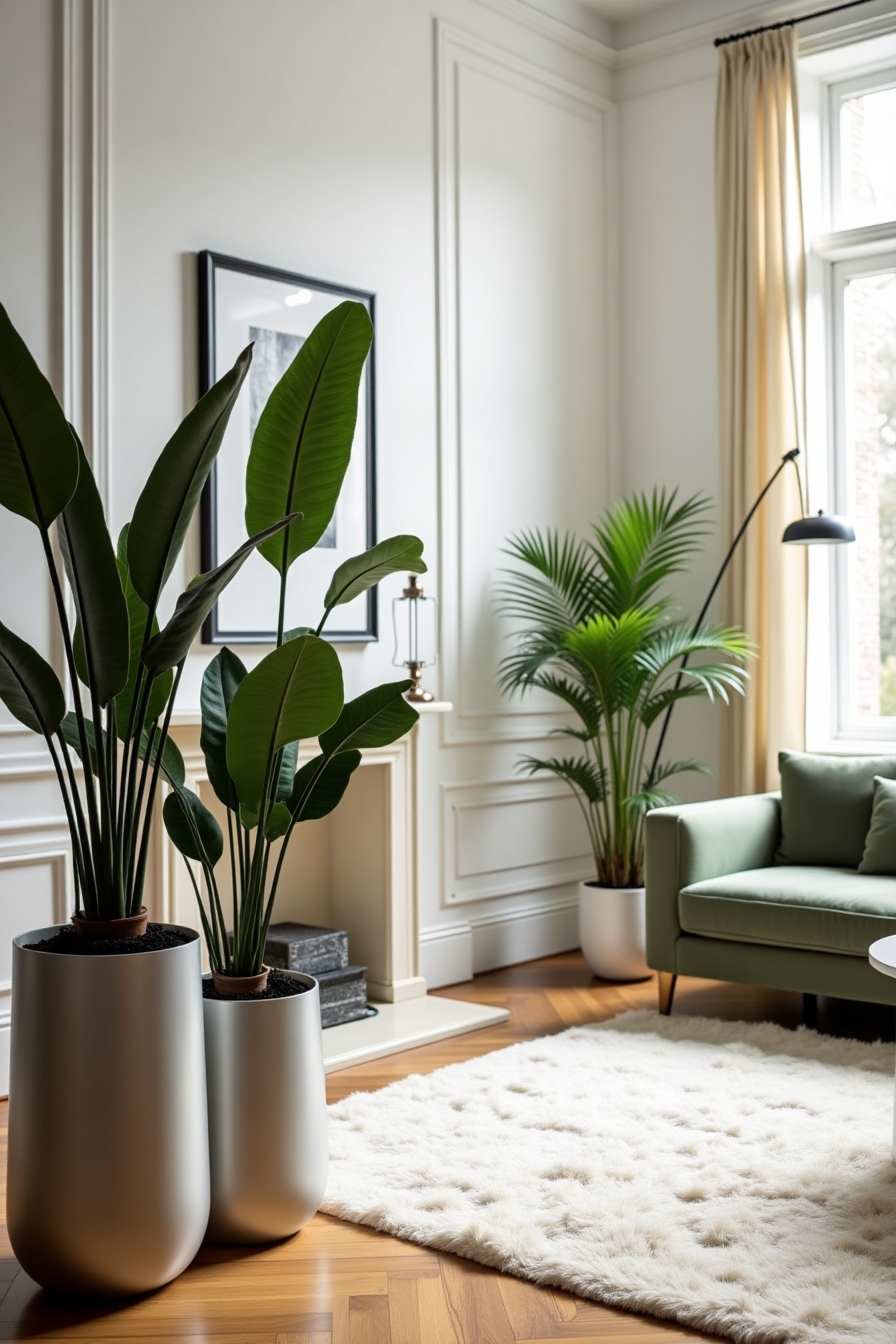That moment of standing in a living room doorway and feeling a wave of disappointment happens in homes across America every single day.
Living rooms should be sanctuaries that welcome and impress, yet too many end up as confused collections of furniture with no clear identity or style.
The disconnect between our design aspirations and the reality of our spaces often comes from believing that true elegance requires a massive budget or professional intervention.
Transforming a lackluster living area into a space that radiates sophisticated charm doesn’t require gutting the room or spending a fortune on designer pieces.
The difference between ordinary living rooms and those that leave lasting impressions often comes down to understanding a handful of design principles that professionals rely on consistently.
These thirteen proven strategies can revolutionize any living space by focusing on specific elements that create maximum impact with minimal investment.
With thoughtful implementation of these ideas, any living room can transition from merely functional to genuinely memorable, regardless of its starting point or square footage limitations.
Statement Lighting That Commands Attention

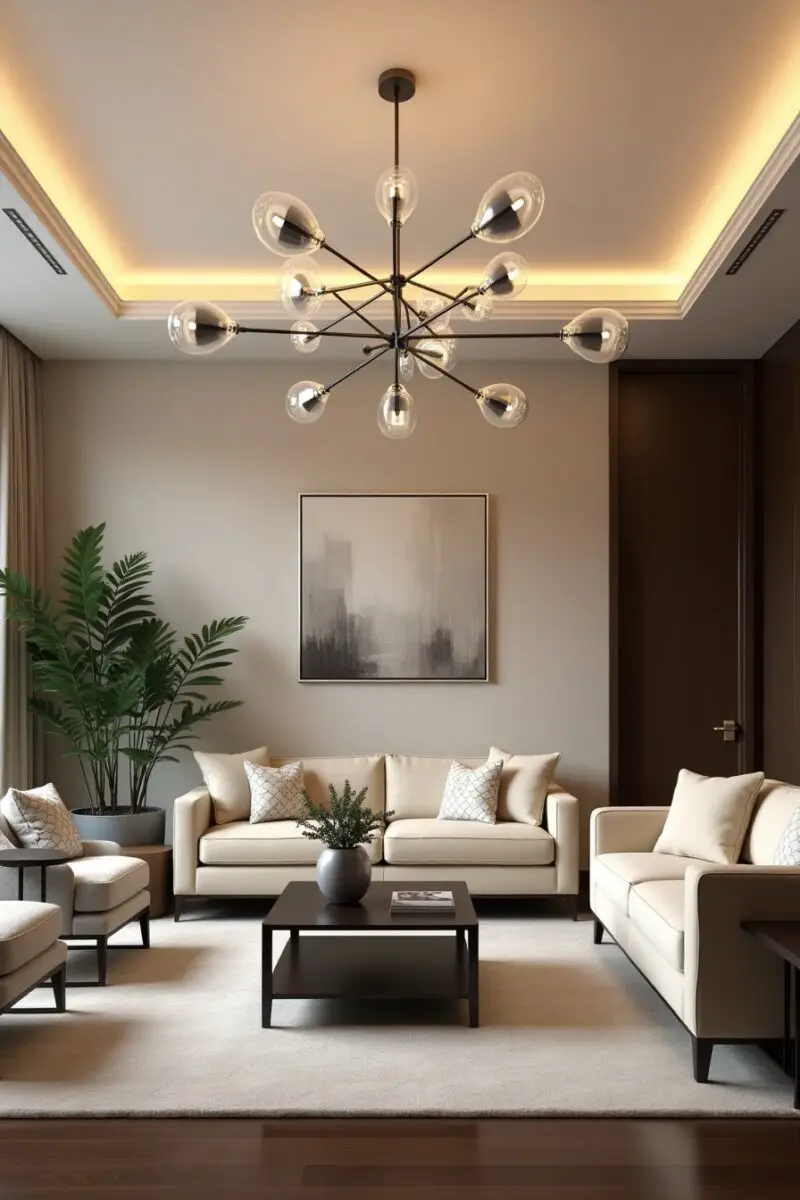
The quickest way to elevate your living room from ordinary to extraordinary is through statement lighting that serves as functional art.
A dramatic chandelier or uniquely designed pendant light instantly draws the eye upward, creating vertical interest and establishing a focal point that sets the tone for your entire space.
Consider fixtures with mixed metals, geometric shapes, or organic forms that reflect your personal aesthetic while providing the perfect illumination for different moods and activities.
The beauty of statement lighting lies in its ability to transform a room without requiring you to replace a single piece of furniture – just switching out a basic ceiling fixture for something with character can redefine your entire space.
Look for options with adjustable heights or dimmable features to maximize both function and ambiance throughout different times of day.
Installation might seem daunting, but many modern fixtures come with user-friendly mounting systems, or you can hire an electrician for a few hours to ensure everything is safely connected.
The shadows and light patterns cast by an interesting fixture add another dimension to your walls and ceiling that standard lighting simply cannot achieve.
When selecting your statement piece, consider the scale of your room – larger spaces can accommodate more dramatic pieces, while smaller rooms might benefit from something striking but not overwhelming.
Don’t be afraid to mix lighting styles throughout your space, as long as there’s a common element (like finish, shape, or design era) that creates a sense of cohesion.
Your lighting choice often becomes a conversation starter when guests visit, giving you the perfect opportunity to share the story behind your selection.
Remember that even the most stunning fixture needs proper maintenance – regular dusting and occasional cleaning will keep your statement piece looking its absolute best.
Layered Textiles That Create Depth and Comfort
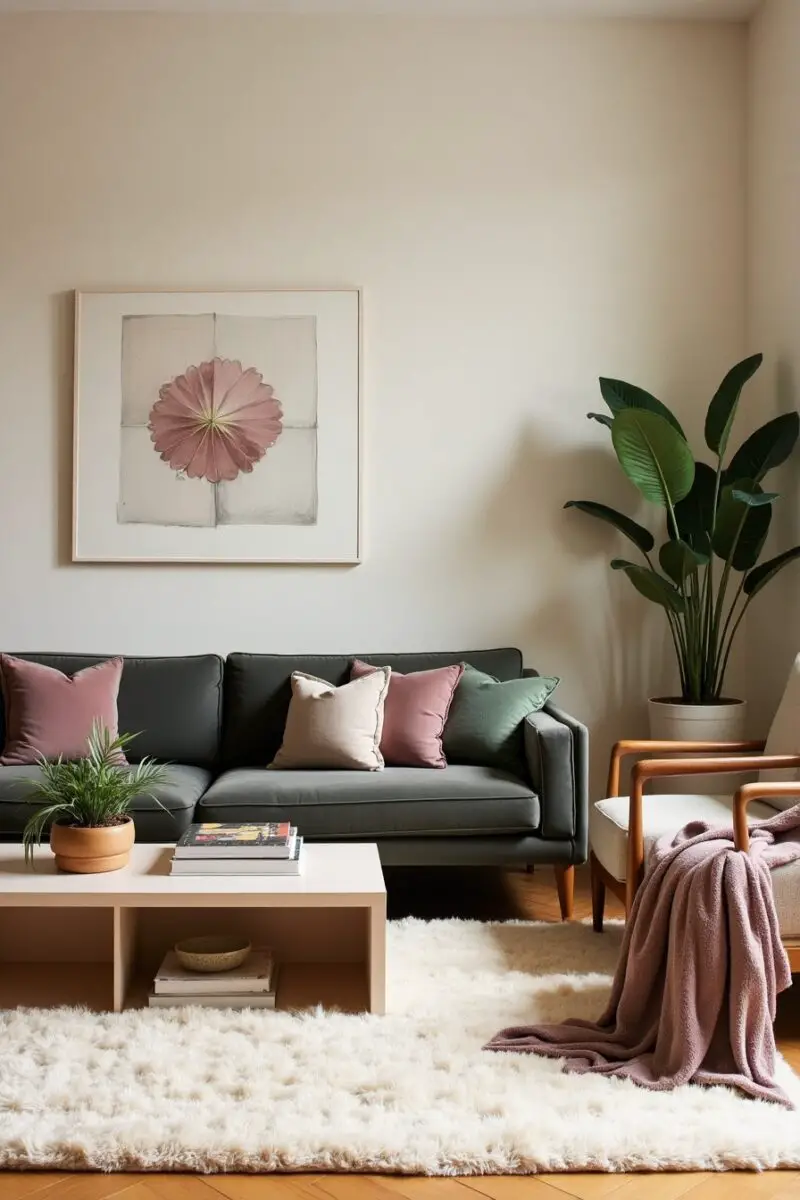
Nothing says elegance quite like a thoughtfully layered approach to textiles that invites both visual interest and physical comfort.
Start with a foundation rug that anchors your seating area – consider natural fibers like wool or silk for their longevity and inherent luxurious quality.
Add dimension by incorporating throw pillows in varying sizes, textures, and patterns while maintaining a cohesive color story that complements your overall design scheme.
The secret to sophisticated layering is mixing high and low textures – perhaps pairing a sumptuous velvet pillow with a more casual linen one, creating contrast that feels intentional rather than haphazard.
Window treatments offer another opportunity for textile layering, where combining sheer panels with more substantial drapes allows for light control while adding visual weight to your walls.
Consider the seasonality of your textiles, perhaps rotating heavier fabrics like wool and velvet during colder months with lighter linens and cottons when temperatures rise.
The most elegant rooms feature textiles with tactile variation – incorporate elements you want to reach out and touch, from nubby bouclé to smooth satin.
Don’t overlook the humble throw blanket, which can be artfully draped over a sofa corner or neatly folded over an ottoman, adding both practical warmth and a finishing design touch.
Pay attention to the scale of patterns when mixing textiles – combining a large-scale floral with a medium geometric pattern and small-scale texture creates visual harmony without overwhelming the eye.
Quality matters more than quantity when it comes to textiles – investing in fewer, better pieces will create a more elegant impression than numerous lower-quality options.
Remember that textile maintenance contributes to the overall elegance of your space – regular cleaning, fluffing of pillows, and proper storage of seasonal items ensures your textiles continue to look their best.
Design Your Dream Room in Minutes!
🏡 Start Creating FREE →Gallery Walls
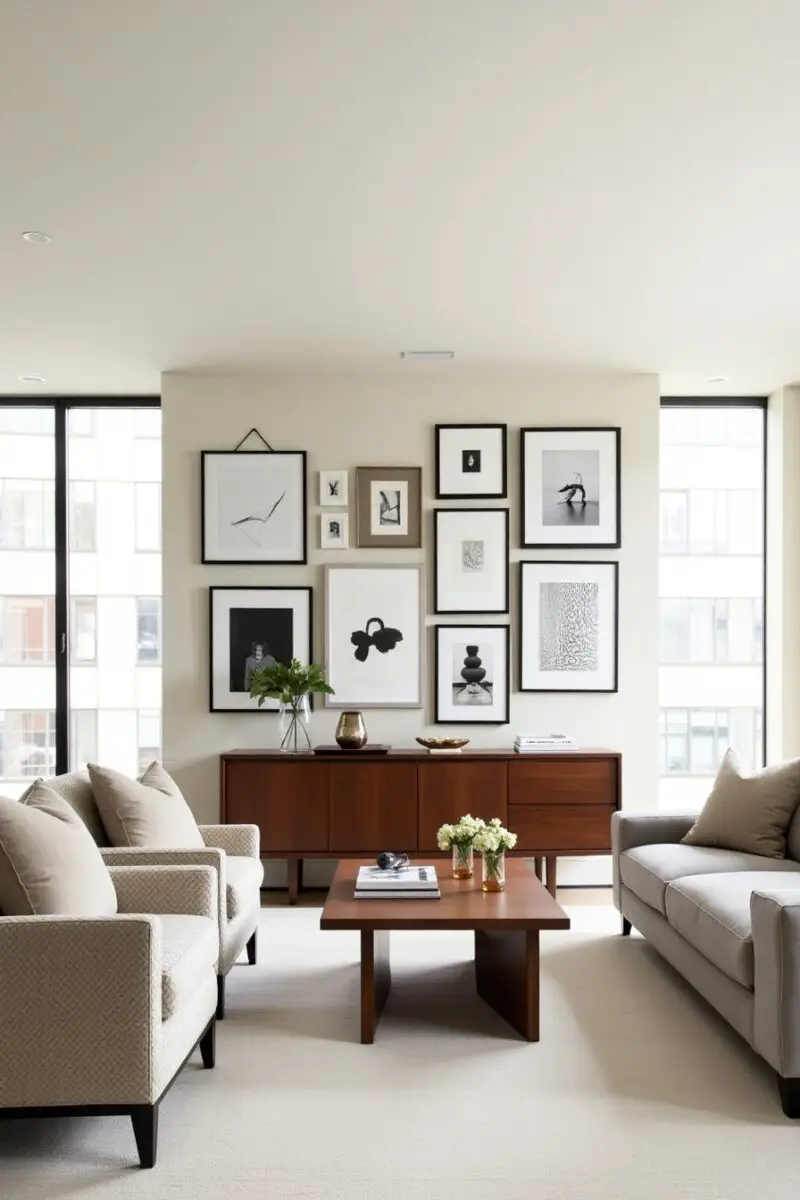
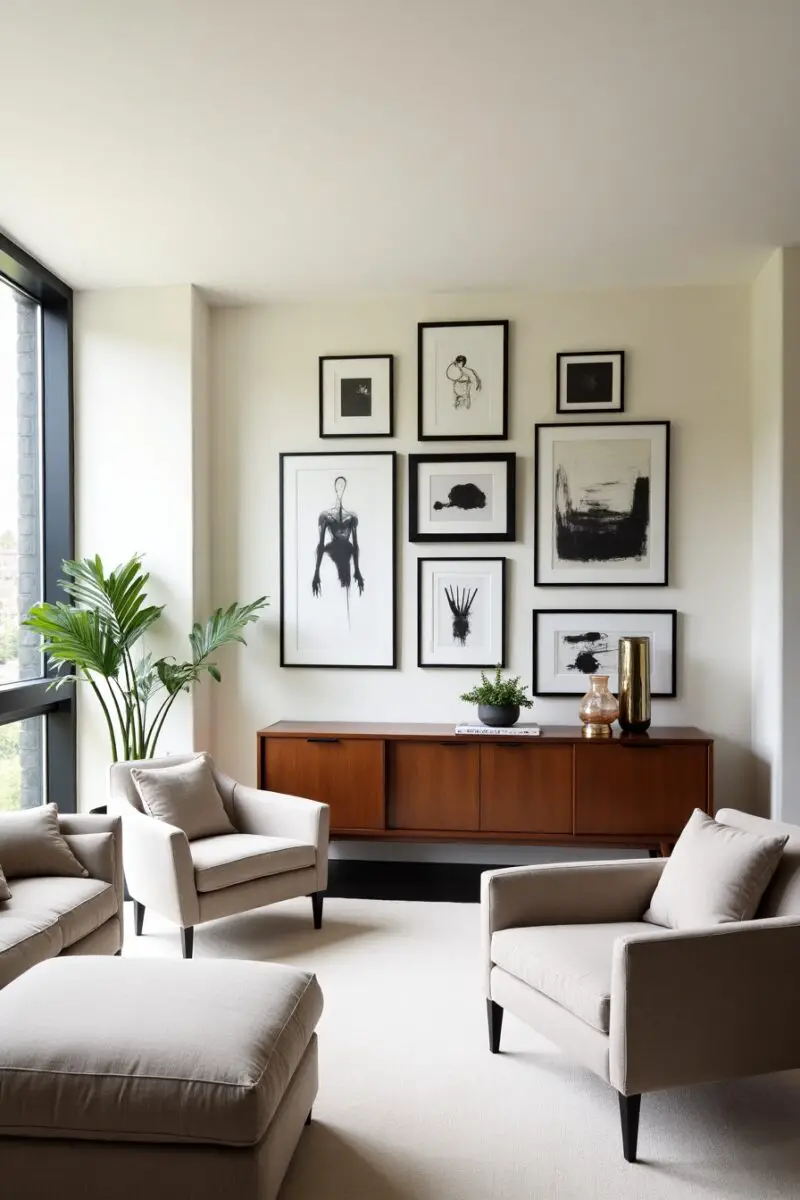
A thoughtfully curated gallery wall transforms ordinary living room walls into a personal museum that tells your unique story.
The most compelling gallery walls combine varied elements – perhaps mixing framed photography with paintings, small sculptural pieces, and meaningful memorabilia.
The key to an elegant (rather than cluttered) gallery wall lies in finding a unifying element – this might be consistent frame finishes, a color story, or even a thematic connection between the pieces.
Before hammering a single nail, experiment with your layout by arranging the pieces on the floor and taking photos from above, allowing you to visualize different configurations without committing.
Consider the spacing between pieces – too close creates visual tension, while too far apart makes the arrangement feel disconnected rather than cohesive.
Unexpected additions like small wall sconces, tiny shelves for three-dimensional objects, or even mounting a small plant within your gallery create dynamic interest that flat pieces alone cannot achieve.
The most sophisticated gallery walls often incorporate negative space – allowing certain areas to breathe prevents visual overload and draws more attention to your carefully selected pieces.
Consider the story your gallery wall tells as visitors move through your space – perhaps it begins with ancestral photos and transitions to representations of your current life and aspirations.
Lighting your gallery wall deserves special attention – small picture lights, nearby lamps with adjustable heads, or strategic ceiling spots can dramatically enhance the impact of your display.
Don’t feel constrained by perfect symmetry – asymmetrical arrangements often feel more collected and authentic, though they benefit from an underlying sense of balance.
Remember that the most engaging gallery walls evolve over time – leaving space for new additions allows your wall to grow with your experiences and aesthetic development.
Quality framing elevates even modest artwork, so consider investing in acid-free matting and UV-protective glass for pieces with personal significance or value.
The beauty of a gallery wall lies in its ability to be both deeply personal and visually striking – creating a focal point that immediately communicates your unique perspective to anyone who enters your home.
Strategic Mirror Placement for Expanded Space
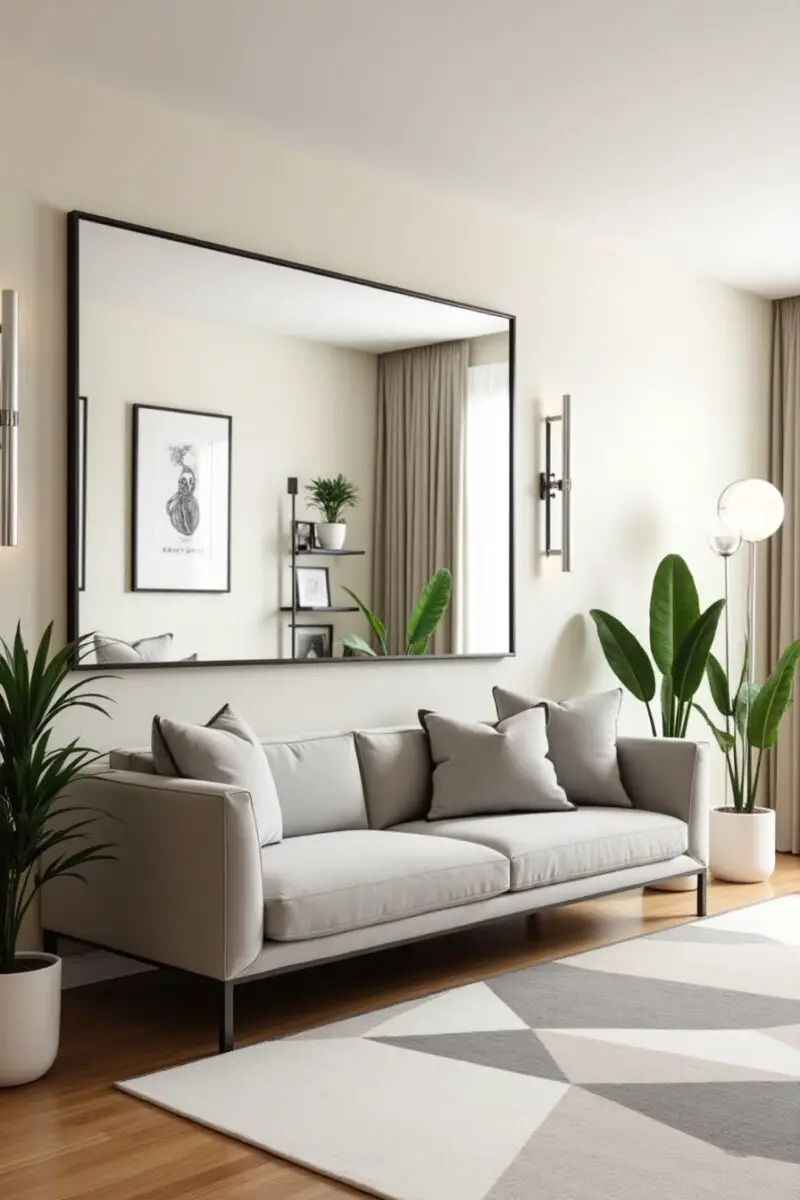
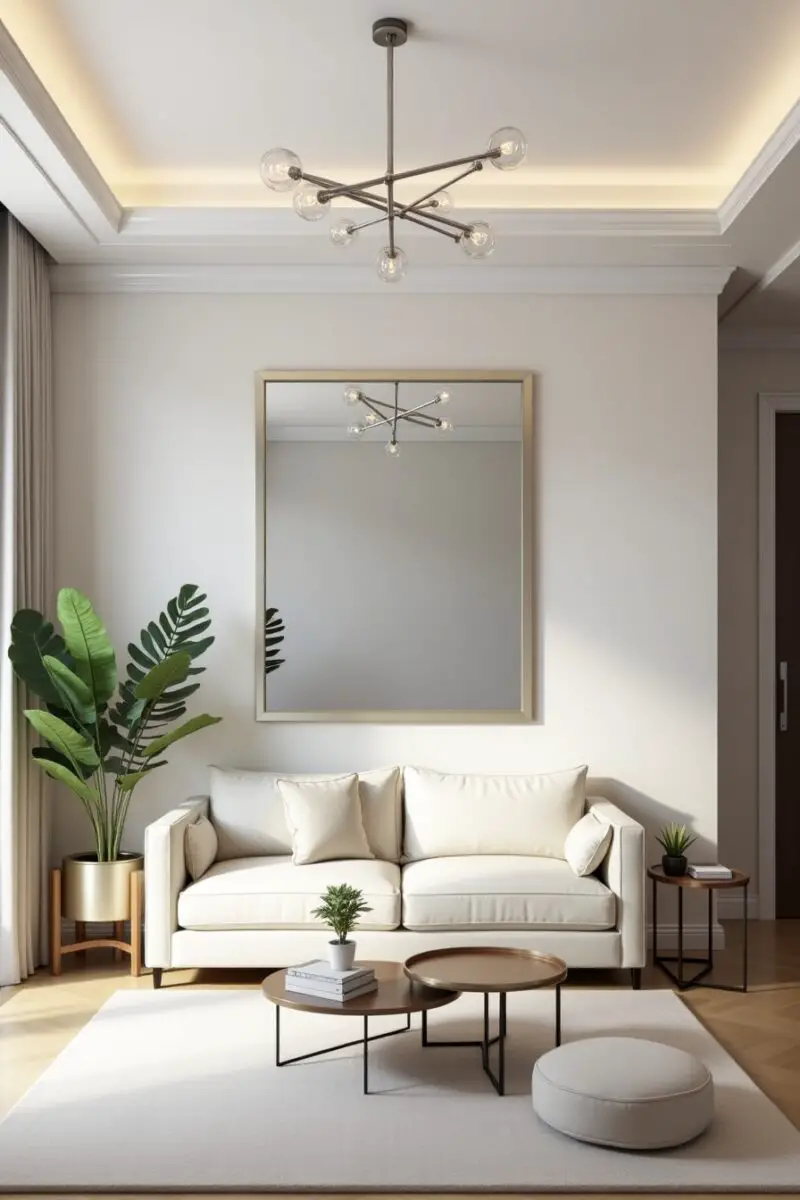
Few design elements offer the transformative power of a well-placed mirror, which simultaneously serves as functional art while creating the illusion of expanded space.
The classic approach of positioning a mirror to reflect a window not only doubles the natural light in your room but creates the magical impression of an additional view.
Consider the reflection itself as a compositional element – a mirror that reflects a beautiful lighting fixture or artwork essentially doubles your investment in those pieces.
Oversized mirrors make particularly dramatic statements in living rooms, especially when leaned against a wall rather than hung, creating a casual elegance that feels both current and timeless.
Groupings of smaller mirrors arranged in a deliberate pattern can be even more impactful than a single large piece, creating a custom art installation that amplifies light from multiple angles.
Look beyond standard shapes – circular mirrors soften angular room architecture, while unusual forms like arches or organic shapes add unexpected visual interest to standard walls.
The frame of your mirror contributes significantly to its design impact – ornate gilded frames evoke traditional elegance, while sleek metal or minimalist wood frames create more contemporary sophistication.
Consider the placement height carefully – mirrors hung at eye level when standing may create awkward reflections, while those positioned to reflect the upper portion of the room often create a more pleasing visual effect.
Strategic mirror positioning can correct proportional challenges in your space – a horizontally oriented mirror can visually widen a narrow room, while a vertical mirror draws the eye upward in rooms with low ceilings.
Don’t limit mirrors to walls – mirrored furniture pieces like side tables or cabinet fronts add reflective qualities at different heights, creating depth throughout the room rather than at just one level.
For truly innovative applications, consider antiqued or smoked mirror finishes which reflect light and space while adding an element of mystery and patina that flat, clear mirrors cannot achieve.
Remember the psychological impact of mirrors – they not only make spaces feel larger but also more energetic, making them particularly valuable in living rooms that feel dim or confined.
Proper cleaning maintains the magic – regular dusting and streak-free cleaning ensures your mirrors continue their space-expanding work without calling attention to maintenance needs rather than design intent.
Mixing Vintage and Modern for Authentic Character
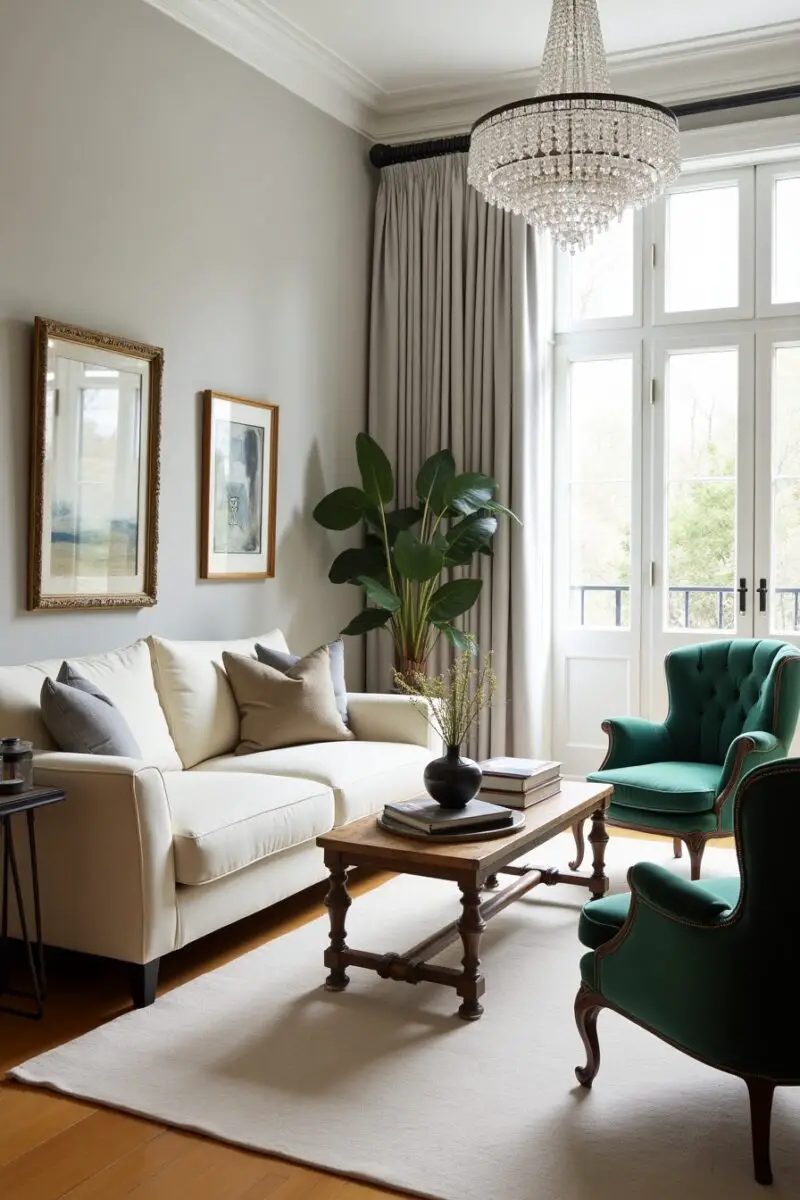
The most captivating living rooms avoid the sterility of matching furniture sets by thoughtfully combining pieces from different eras to create a space that feels collected rather than purchased.
Start by identifying an anchor piece – perhaps a contemporary sofa or a vintage credenza – that establishes the foundational style around which you’ll build the room’s character.
The magic happens in the conversation between old and new – consider pairing a sleek modern coffee table with a weathered antique side chair, allowing each piece to highlight the unique qualities of the other.
Look for opportunities to repurpose vintage pieces in unexpected ways – an antique trunk as a coffee table, a Victorian plant stand as a bar cart, or a midcentury magazine rack as a bathroom storage solution.
The patina of aged wood, the worn upholstery of a beloved chair, or the slight imperfections of handcrafted details bring a depth to your space that brand-new pieces, however beautiful, simply cannot replicate.
Balance is essential – too many vintage pieces can make a room feel like a time capsule, while too few can make those pieces feel out of place rather than intentionally curated.
Consider the architectural context of your home when mixing eras – a Victorian home might beautifully accommodate more contemporary pieces, while a sleek modern apartment can be warmed by strategic vintage additions.
Color creates cohesion between disparate styles – pulling a accent hue from your vintage rug into modern throw pillows creates visual connection across different furniture eras.
Don’t overlook lighting when mixing old and new – a contemporary floor lamp alongside a vintage table creates the perfect stylistic tension that makes a room feel curated rather than coordinated.
The stories behind vintage pieces add narrative depth to your space – knowing the history of a particular chair or the original purpose of a repurposed cabinet creates conversation opportunities while deepening your own connection to your home.
Consider scale carefully when mixing eras – midcentury pieces tend to be lower and sleeker than some traditional designs, so ensure your furniture arrangement accounts for these variations in height and visual weight.
Remember that elegant mixing requires restraint – editing is often more important than adding, ensuring each piece has room to be appreciated rather than lost in a crowded arrangement.
The most sophisticated mixed-era rooms maintain a sense of intention – there should be a felt harmony, even amidst deliberate contrast, that communicates careful curation rather than random collection.
Embracing Negative Space for Refined Elegance
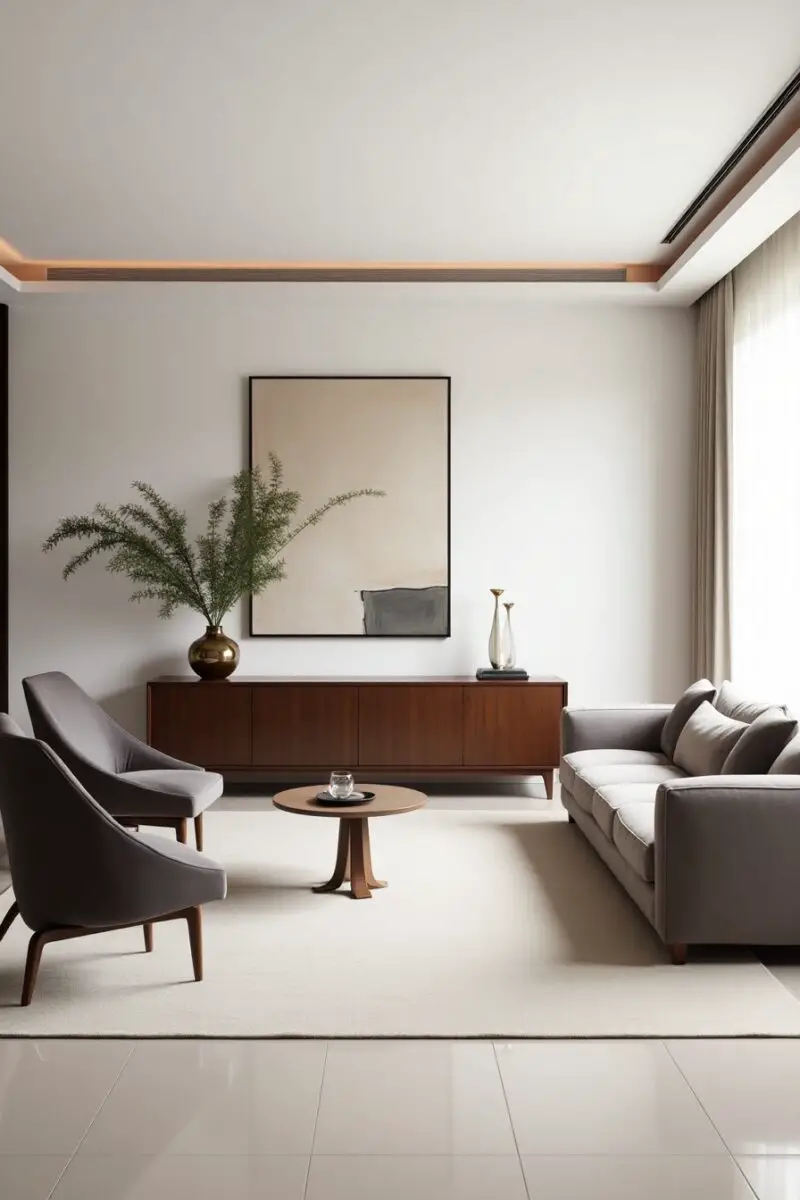
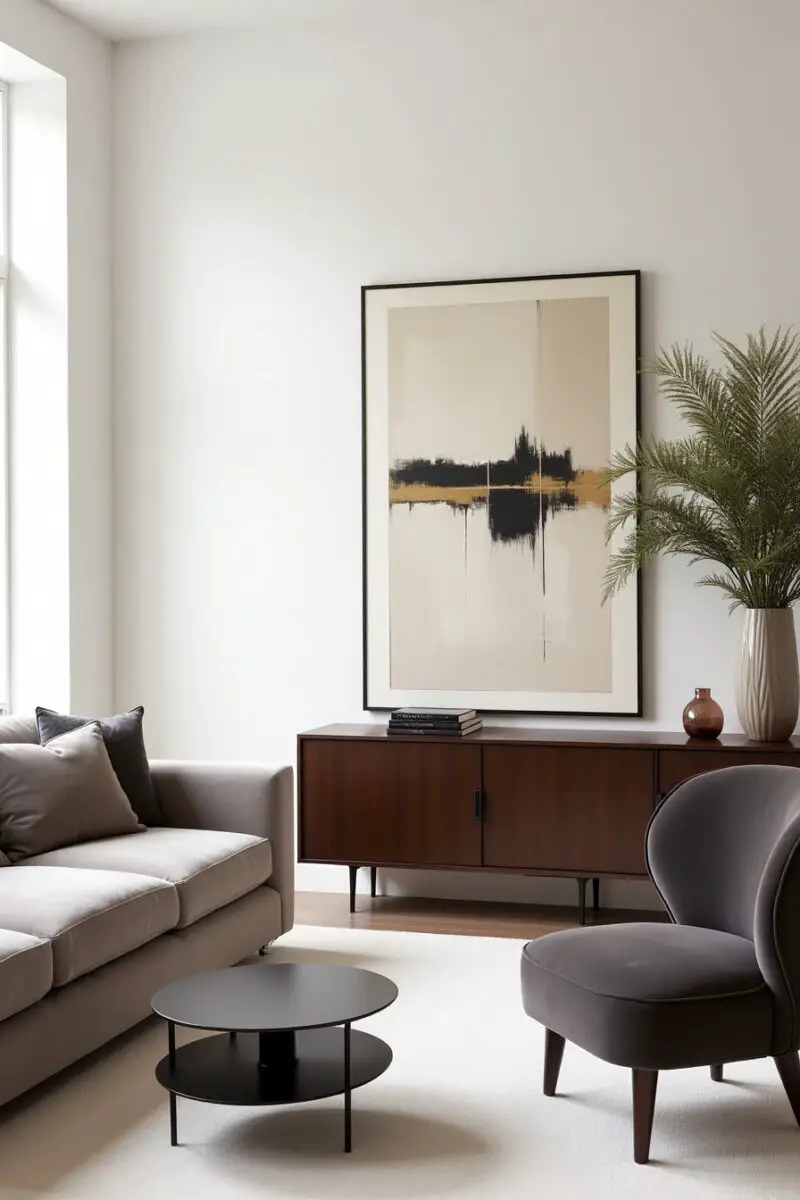
The most sophisticated living rooms aren’t defined by what they contain, but rather by their thoughtful restraint – the deliberate inclusion of negative space that allows the eye to rest.
Breaking free from the instinct to fill every surface and corner creates a sense of intentionality that immediately elevates your space from cluttered to curated.
Consider the invisible pathways through your room – allowing clear circulation space not only improves functionality but creates a visual breathing room that feels inherently luxurious.
The Japanese concept of “ma” – the meaningful space between objects – offers a powerful framework for understanding how emptiness itself can become a design element with its own beauty and purpose.
Start by removing items from your current arrangement – you might be surprised to discover that subtracting a side table, relocating a plant, or removing decorative objects immediately creates a more elegant impression.
Wall space deserves the same consideration as floor space – resisting the urge to hang art on every vertical surface allows the pieces you do display to command more attention and appreciation.
Think of negative space as the visual equivalent of silence in music – without these deliberate pauses, the composition becomes overwhelming noise rather than harmonious melody.
Scale your furniture appropriately to your room dimensions – oversized pieces that barely allow for movement create a sense of constriction, while appropriately scaled items with space between them suggest abundance.
Consider the view from each seating position – ensuring that sight lines remain relatively uncluttered from multiple angles creates a sense of spaciousness regardless of your room’s actual dimensions.
The luxury of empty space extends to storage solutions as well – leaving some shelves partially empty or maintaining one simplified surface amidst more decorated areas creates visual rhythm and relief.
Notice how light interacts with your negative space – empty areas allow sunlight to create interesting shadow patterns that become subtle, ever-changing design elements throughout the day.
Remember that negative space doesn’t mean sterile minimalism – even traditionally ornate styles benefit from strategic breathing room that prevents visual exhaustion.
The confidence to leave space unfilled communicates a design maturity that distinguishes truly elegant interiors from those that feel overeager or insecure in their styling approach.
Indoor Plants for Natural Sophistication
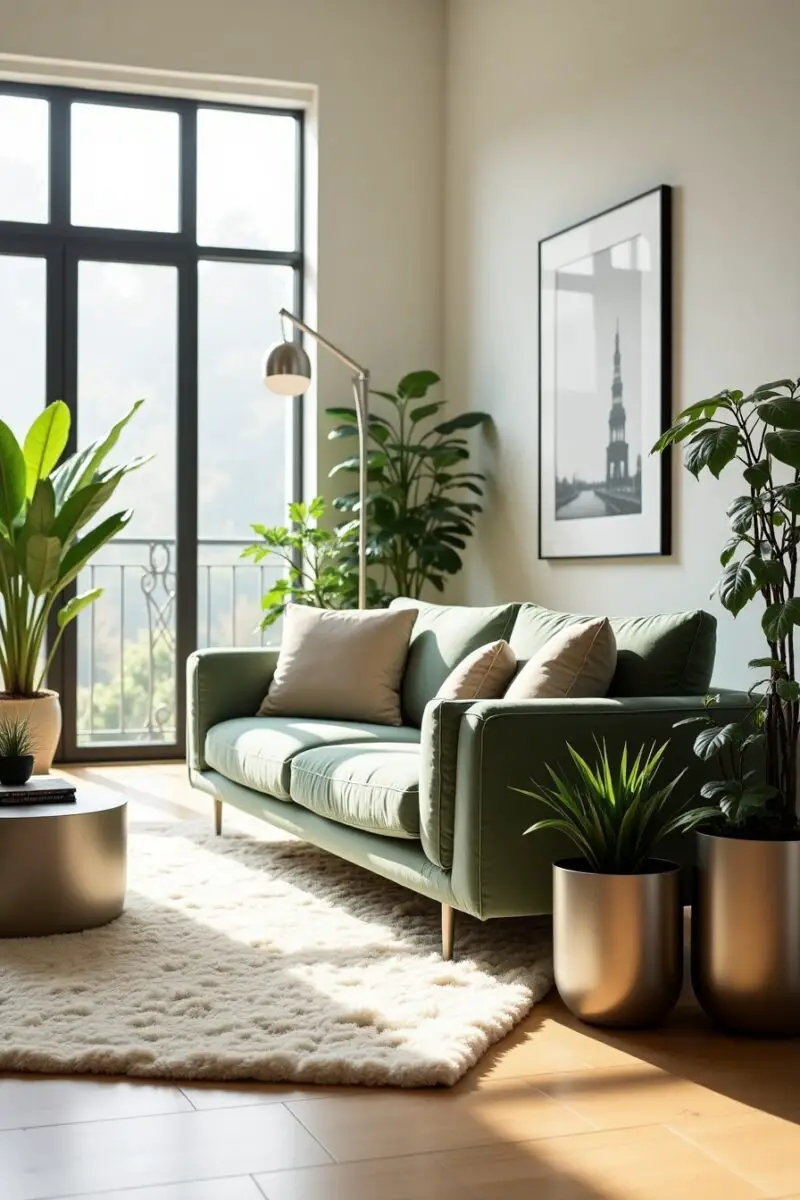

Nothing breathes life into a living room quite like carefully selected and positioned plants that introduce organic shapes, movement, and connection to the natural world.
Beyond their aesthetic contribution, indoor plants actually improve your living environment by filtering air pollutants, increasing humidity, and creating a subtle biophilic connection that research shows reduces stress and enhances wellbeing.
Start by selecting specimen plants with dramatic architectural qualities – a statuesque fiddle leaf fig, a sculptural bird of paradise, or a cascading pothos – that serve as living sculptures within your design composition.
The containers housing your plants deserve as much consideration as the plants themselves – handcrafted ceramic vessels, vintage brass planters, or minimalist architectural pots elevate greenery from mere houseplants to design statements.
Consider the play of light and shadow that plants uniquely create – the filtered sunlight through a monstera’s perforations or the delicate shadow patterns of a palm frond add dynamic visual interest that static decor cannot replicate.
Strategic plant placement creates natural room divisions or highlights architectural features without requiring additional furniture – a tall plant can frame a doorway while a trailing specimen draws attention to shelving elevations.
The varied greens of different plant species create a subtle palette that complements virtually any color scheme while introducing a depth of natural variation that feels simultaneously soothing and visually complex.
Don’t overlook the sensory dimensions beyond the visual – certain plants like jasmine, gardenia, or lavender introduce subtle fragrances that transform the atmospheric quality of your space on multiple sensory levels.
Grouping plants of varying heights, textures, and growth habits creates more impactful arrangements than distributing individual specimens throughout the room – consider creating a dedicated plant corner that serves as a living focal point.
Plant stands, wall-mounted planters, and hanging systems add vertical interest while freeing valuable surface space – look for options that complement your existing furniture finishes for a cohesive look.
Seasonal rotation keeps your plant display fresh and engaging – perhaps highlighting flowering plants in spring, lush foliage in summer, and more structural specimens during winter months.
Remember that healthy, thriving plants communicate attention to detail and care – regular maintenance ensures your living décor continues to enhance rather than detract from your elegant interior.
TRENDING NOW
13 Dark And Moody Living Room Ideas You'll LoveCoffee Table Styling With Intention
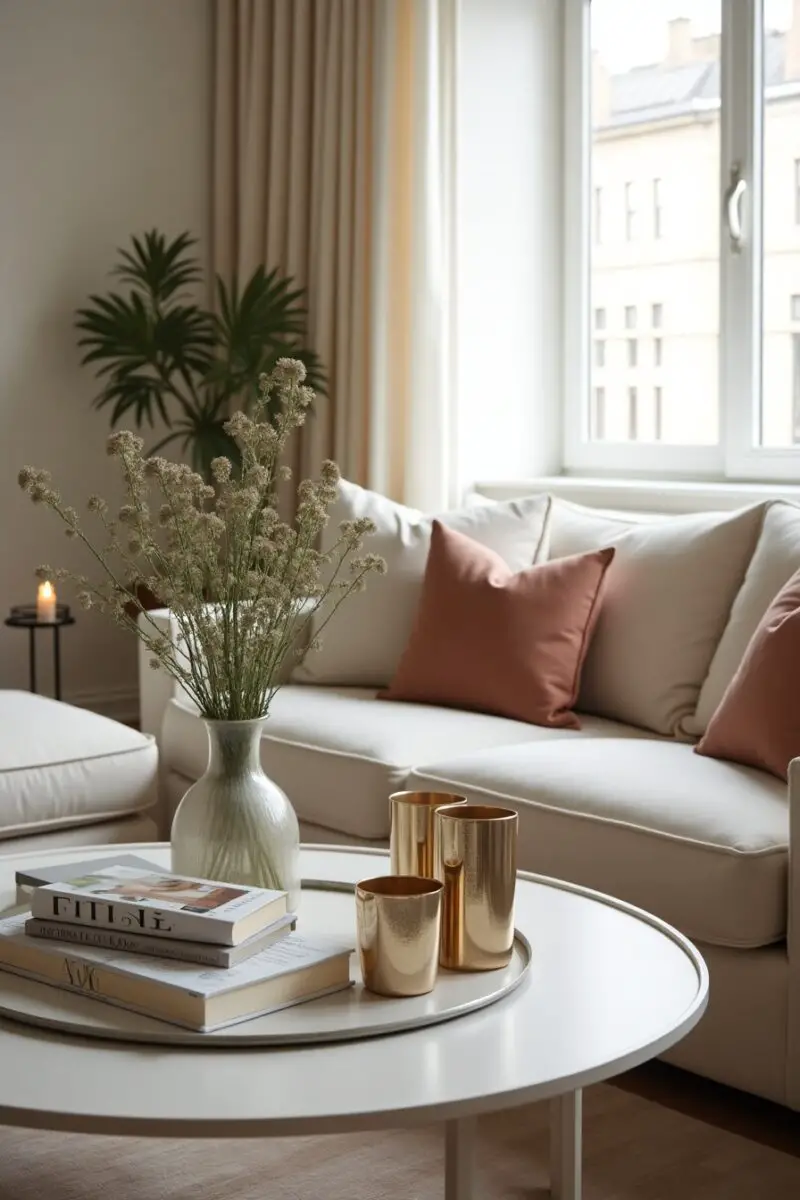
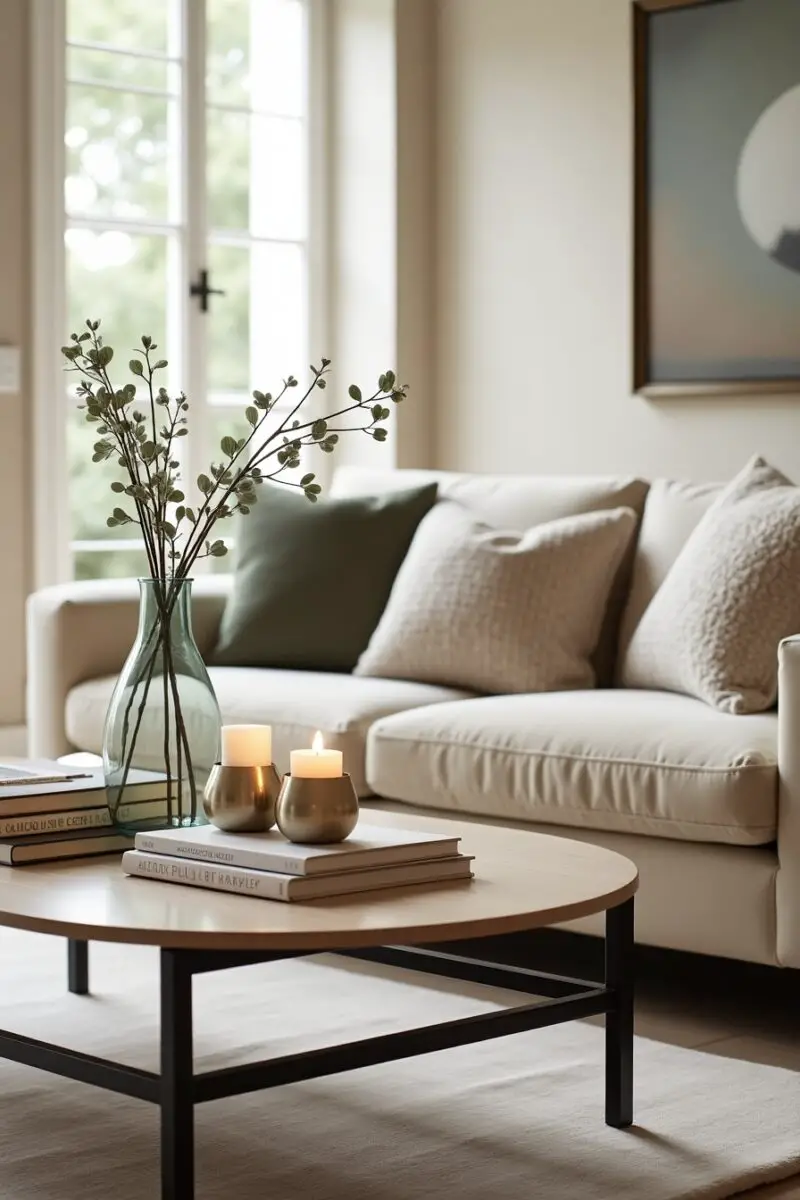
The coffee table represents prime real estate in your living room – a natural focal point that offers the perfect canvas for a thoughtfully curated vignette that balances beauty and function.
Start with a foundation of contrasting heights – perhaps stacking design books alongside a lower decorative box or bowl – creating visual movement that guides the eye across your arrangement.
Consider the rule of three when selecting objects, grouping items in odd numbers which naturally creates more dynamic and visually pleasing compositions than symmetrical pairs.
Introduce elements that invite interaction – a unique object that begs to be handled, a small game that can be casually played, or an interesting book that actually gets opened rather than merely displayed.
Personal artifacts that tell your story – perhaps a souvenir from meaningful travel, a family heirloom with history, or an artisanal piece created by someone you know – add authentic character that generic decor cannot achieve.
Remember that negative space remains essential even in small vignettes – allowing some empty table surface prevents your arrangement from feeling cluttered or overwhelming.
Seasonal adjustments keep your coffee table feeling fresh – perhaps rotating natural elements like branches in spring, shells in summer, or pine cones in winter alongside your more permanent pieces.
Consider the functional needs of those who actually use the space – leaving room for coffee cups, providing coasters that complement your aesthetic, and ensuring nothing feels precarious or easily toppled.
For tables with lower shelves, create visual distinction between levels – perhaps using the top for more curated display items while reserving the bottom for larger books or storage baskets.
Trays serve as both organizing elements and design features – a beautiful tray corrals smaller objects while creating a sense of intentional grouping rather than random placement.
Textural contrast adds sophistication – the smooth coolness of stone or ceramic plays beautifully against rougher natural elements like wood or fibers, creating a multi-sensory experience even in a small arrangement.
Scale matters significantly – avoid tiny objects that feel lost on a substantial table, or oversized items that overwhelm a delicate piece, instead seeking proportion that feels harmonious with your specific furniture.
Remember that the most elegant coffee table styling allows for evolution – leaving room for new discoveries or seasonal changes ensures your arrangement remains an authentic reflection of your current life rather than a static, museum-like display.
Conversation-Focused Furniture Arrangements
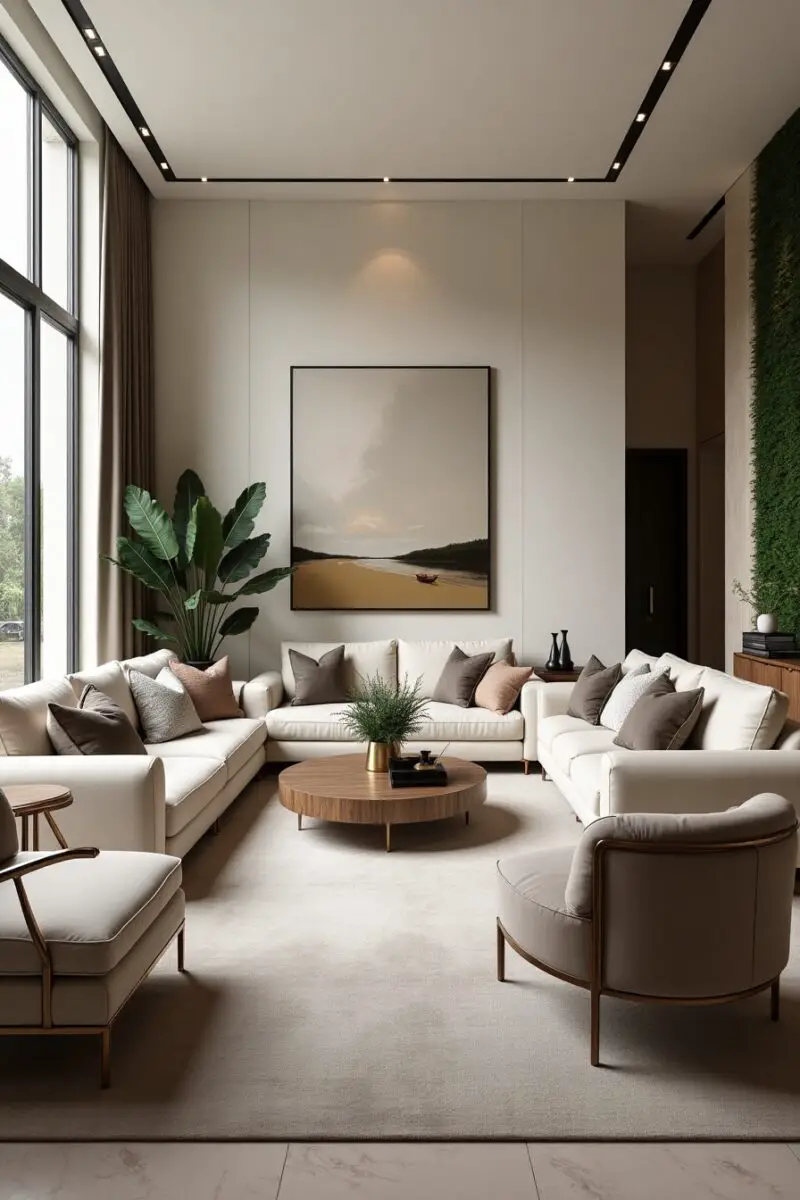
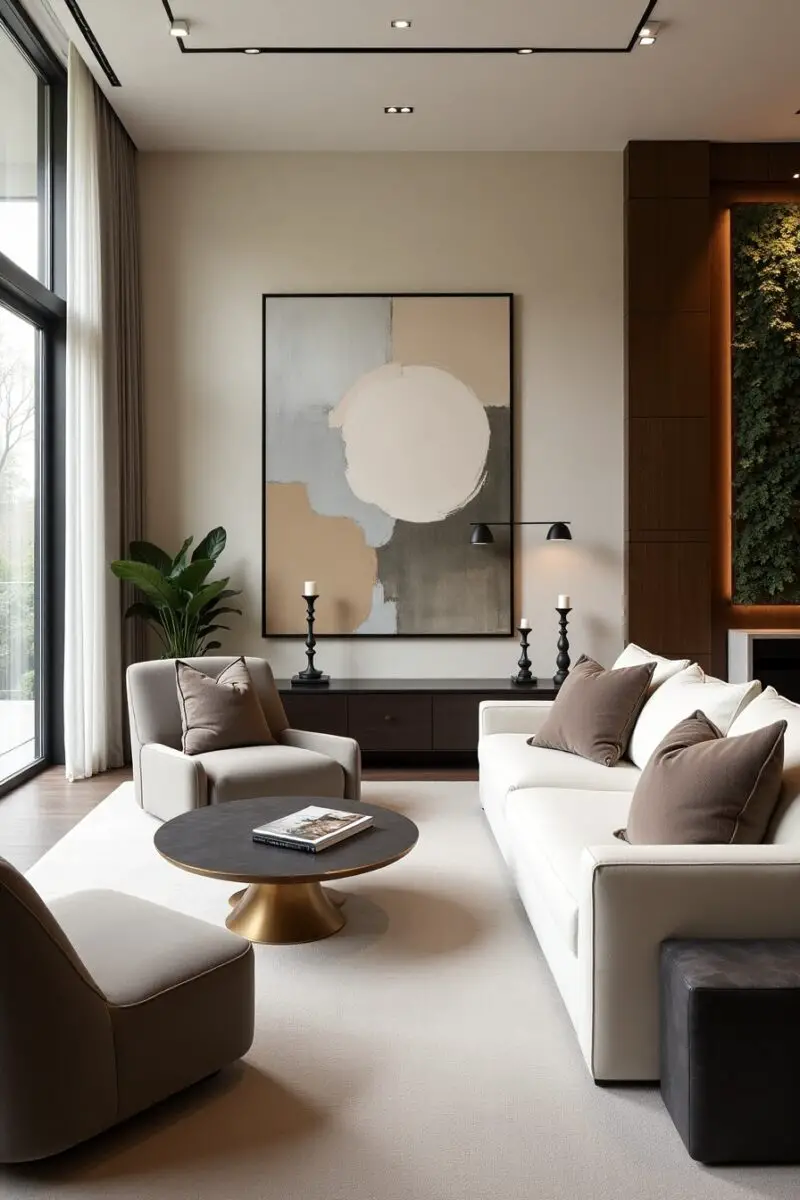
The most inviting living rooms prioritize human connection through furniture arrangements that naturally facilitate conversation rather than focusing primarily on television viewing.
Consider positioning key seating pieces no more than eight feet apart – this optimal distance allows for comfortable conversation without requiring raised voices or straining to hear.
The classic conversation pit – where seating faces inward toward a central point rather than outward toward walls – creates an immediate sense of intimacy and connection that fundamentally changes how the space feels and functions.
Flexible seating elements like ottomans, poufs, or lightweight occasional chairs allow you to expand your conversation circle when entertaining larger groups without permanently committing floor space to rarely-used furniture.
Consider the subtle psychology of seating angles – furniture arranged at slight angles (rather than harsh 90-degree corners) creates a more welcoming, organic flow that subconsciously encourages relaxed interaction.
Anchor your conversation area with a properly-sized rug that unifies the furniture grouping – ideally large enough that at least the front legs of all seating pieces rest within its borders, creating a defined conversation zone.
Don’t overlook the importance of accessible surface spaces – each seat should have easy access to a table surface for placing drinks, books, or other items, eliminating the awkward reach or precarious balancing that disrupts comfortable conversation.
Consider sightlines carefully – arranging furniture to capture natural views through windows or highlight architectural features like fireplaces creates natural conversation topics while enhancing the room’s connection to its surroundings.
Lighting designed specifically for conversation creates essential ambiance – aim for eye-level illumination through table lamps or sconces rather than relying solely on overhead fixtures that can create unflattering shadows during face-to-face interactions.
For rooms that must accommodate both conversation and television viewing, consider furniture with swivel capabilities or lightweight pieces that can be easily repositioned as needed for different activities.
Pay attention to the subtle hierarchy created through different seating options – perhaps offering a statement chair for a natural “host” position while providing equally comfortable but visually secondary options for guests.
Remember that conversation-friendly rooms anticipate practical needs – incorporating subtle storage for items like throws, reading materials, or games eliminates the disruption of having to leave the conversation area to retrieve these items.
The most successful conversation-focused arrangements respect both introverts and extroverts – perhaps including a slightly removed seating option that allows for participation from a more comfortable distance while still feeling connected to the group.
TRENDING NOW
13 Stunning Brown And Blue Living Room IdeasHidden Storage Solutions for Clutter-Free Elegance
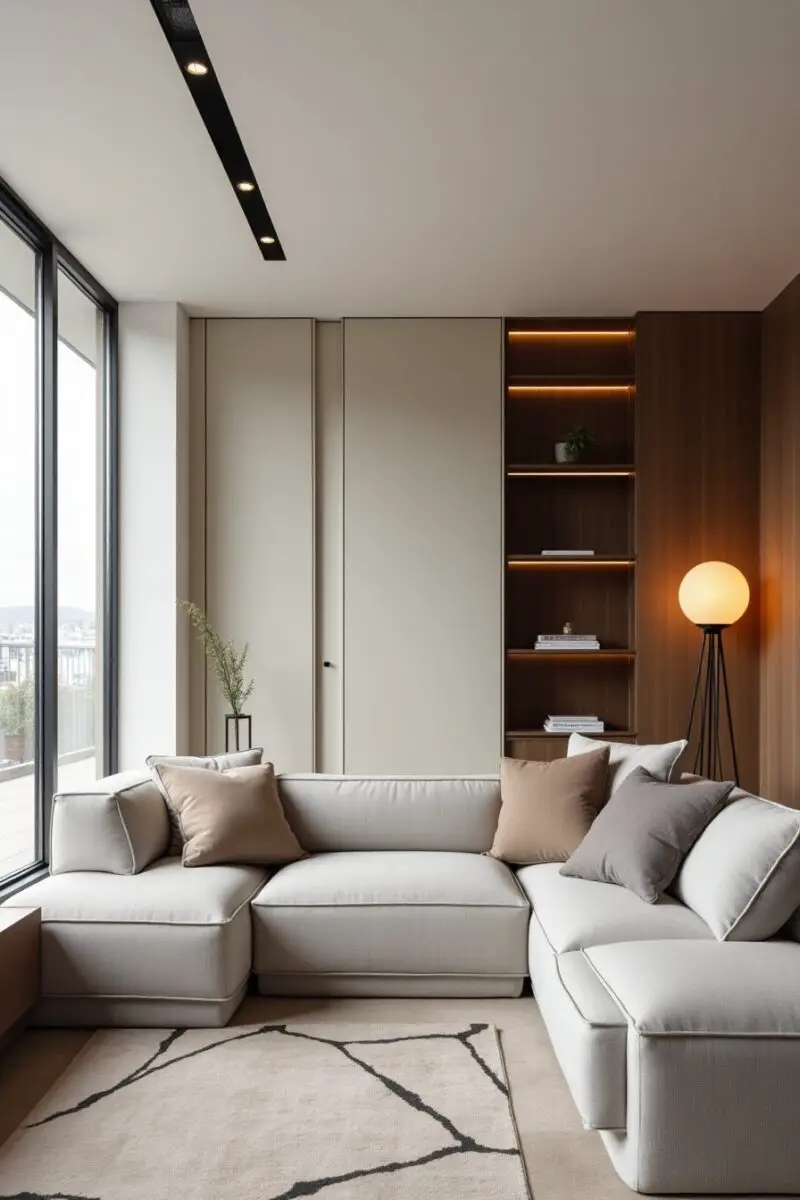
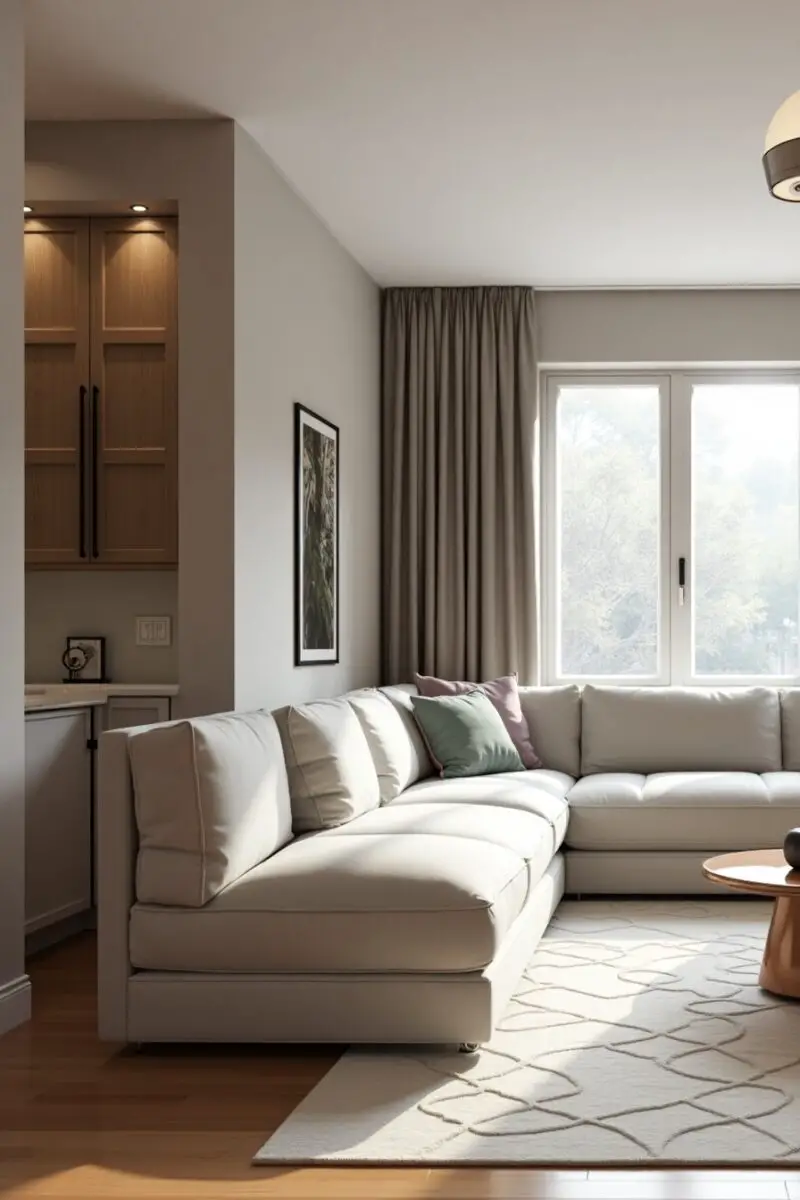
The hallmark of truly sophisticated living rooms isn’t the absence of everyday items, but rather the thoughtful concealment of necessary objects that allows the eye to focus on beauty rather than utility.
Consider furniture that performs double-duty – ottomans with removable tops, coffee tables with hidden compartments, or side tables with discreet drawers allow functionality without visual chaos.
Built-in solutions, when possible, create the cleanest aesthetic – bookshelves flanking a fireplace, window seats with lift-up storage, or custom media walls eliminate the need for additional furniture pieces while maximizing storage capacity.
For rental spaces where permanent solutions aren’t possible, furniture placement can create hidden storage zones – perhaps positioning a sofa slightly away from the wall to create a narrow shelf space behind, or using a decorative screen to conceal practical storage bins.
The space beneath sofas or chairs offers untapped storage potential – shallow, wheeled containers can house rarely-used items while remaining completely invisible to anyone enjoying your space.
Consider vertical storage opportunities that draw the eye upward – tall cabinets with closed lower sections and display areas above allow you to hide practical items while showcasing your most beautiful possessions.
Decorative baskets and boxes that complement your aesthetic serve as both storage solutions and design elements – opt for consistent materials or colors to create a sense of intentionality rather than random collection.
Remember that elegantly concealed storage requires organizational systems within – drawer dividers, labeled containers, and categorical grouping ensure you can actually find and use the items you’ve stored away.
Strategic use of furniture arrangement can create natural “drop zones” just outside the main living space – perhaps a beautiful console table in an adjacent hallway to capture items before they migrate into your carefully styled room.
Consider how technology creates visual clutter – solutions like wireless charging stations built into furniture, decorative boxes that hide routers and cables, or frames that transform televisions into art when not in use maintain technological convenience without aesthetic compromise.
For items used daily but not continuously, create accessible but concealed homes – perhaps a decorative cabinet for board games, a stylish bar cart that can be wheeled away when not entertaining, or an elegant lidded container for remote controls.
Remember that the goal isn’t sterile minimalism but rather thoughtful curation – some items deserve display while others serve better from behind the scenes, with the distinction based on both function and beauty.
The most sophisticated storage solutions anticipate future needs – leaving some capacity unused ensures you can accommodate new acquisitions without immediately creating visible clutter that undermines your elegant aesthetic.
TRENDING NOW
13 Japandi Living Room Designs To Inspire SimplicityArchitectural Moldings for Timeless Sophistication
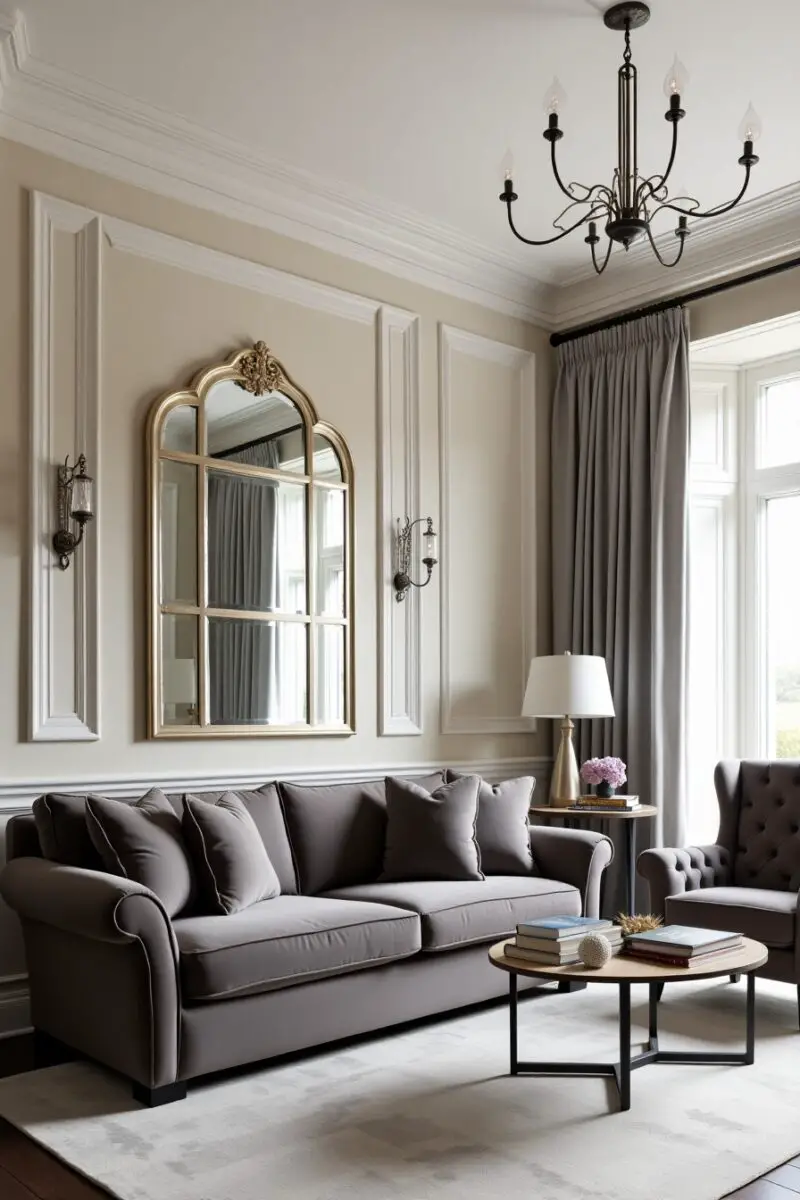

Few design elements communicate timeless elegance as effectively as architectural moldings that transform plain walls and ceilings into surfaces with depth, character, and historical resonance.
Even in contemporary spaces, thoughtfully selected moldings create a sense of intention and refinement – whether through minimal picture rail details or more elaborate combinations of crown molding, chair rails, and panel moldings.
The beauty of architectural moldings lies in their ability to enhance your space regardless of furnishing budget – empty rooms with quality millwork immediately possess a sophistication that plain-walled spaces filled with expensive furniture cannot achieve.
Consider the proportional relationships between different molding elements – classical design principles suggest specific ratios between baseboard height, chair rail positioning, and crown molding scale that create naturally harmonious compositions.
For rental spaces where permanent installation isn’t permitted, removable options exist – adhesive moldings, decorative panel systems, or even carefully applied decorative paint techniques can create similar effects without structural modification.
Paint strategy dramatically impacts how moldings are perceived – painting moldings and walls the same color creates subtle sophistication through shadow play, while contrasting colors between wall and trim produces more dramatic definition.
Consider three-dimensional possibilities beyond traditional crown moldings – coffered ceilings, applied panel details, or architectural ceiling medallions create dramatic focal points that elevate the entire room.
Remember that moldings historically served practical purposes – chair rails protected walls from furniture damage, picture moldings provided hanging systems without nail holes, and baseboards covered gaps between walls and floors – allowing you to present their inclusion as both beautiful and functional.
Scale your molding choices appropriately to your ceiling height – more substantial profiles suit taller ceilings, while lower ceilings benefit from simpler, less projecting designs that avoid overwhelming the space.
Consider how moldings can frame other design elements – perhaps using panel molding to create borders around wallpaper sections, or installing picture rail from which artwork can be hung without wall damage.
Mixing molding styles requires careful consideration – while eclecticism can be charming, maintaining consistent design language between different molding elements creates a more cohesive and sophisticated impression.
Remember that proper installation makes all the difference – precisely mitered corners, careful caulking of seams, and proper preparation before painting ensures your moldings enhance rather than detract from your elegant aesthetic.
The investment in quality architectural details often returns both in enjoyment and property value – these timeless elements transcend trends and contribute to the fundamental character of your space in ways that furniture and decorative objects alone cannot achieve.
TRENDING NOW
13 Office-Living Room Combos For Smart SpacesRich Tactile Materials for Sensory Depth
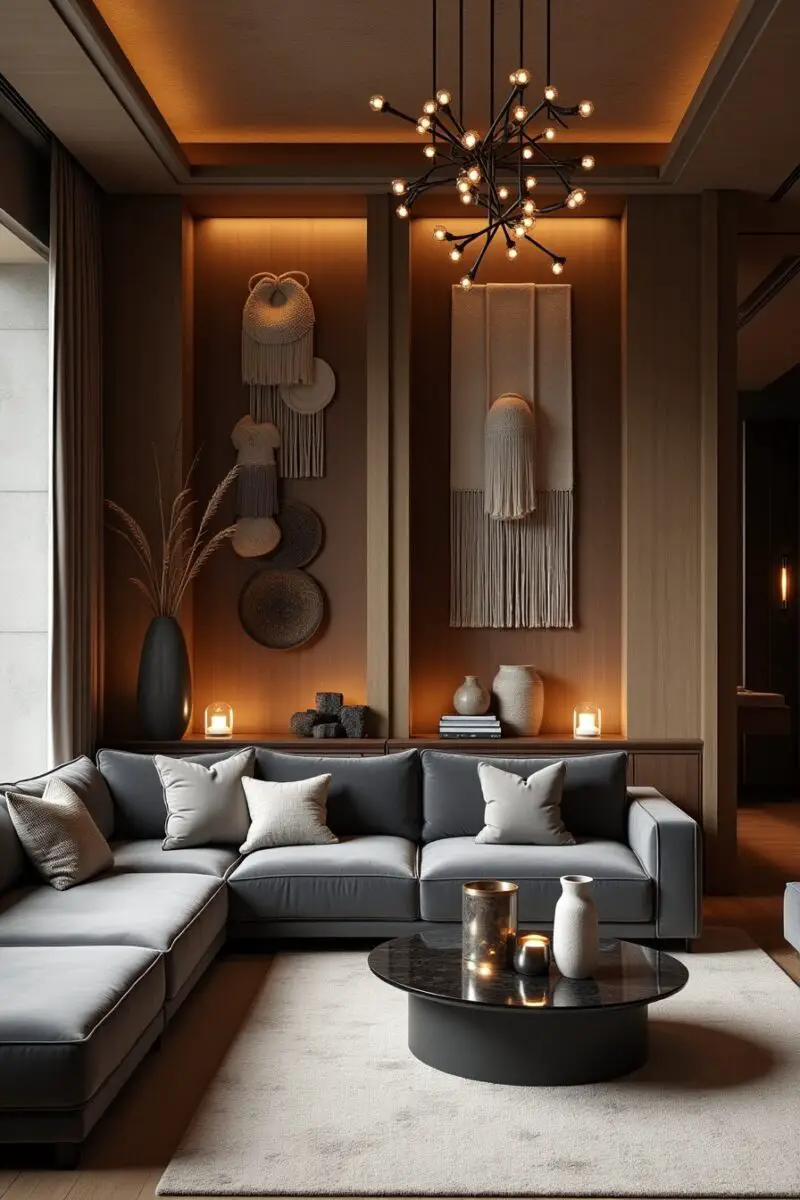
The most memorable living rooms engage multiple senses through deliberately varied textures that invite touch while creating visual depth through light absorption and reflection.
Start by conducting a tactile audit of your current space – noticing which surfaces invite touch and which create distance – then strategically introducing elements that expand the sensory experience of your room.
Consider the psychological impact of different textures – soft materials like velvet and chenille create comfort and invitation, while more structured surfaces like leather or polished wood communicate formality and refinement.
The juxtaposition of contrasting textures creates the most compelling compositions – perhaps pairing a nubby bouclé chair with a sleek marble side table, allowing each material to highlight the qualities of the other.
Natural materials bring inherent textural complexity that manufactured alternatives rarely achieve – the varied grain of solid wood, the subtle irregularities of handwoven textiles, or the unique veining of natural stone creates depth that resists visual fatigue.
Remember that texture exists in both visual and tactile dimensions – materials like grasscloth wallcovering, fluted wood details, or ribbed glass create visual texture even in elements rarely touched directly.
Consider how light interacts with different textures – matte surfaces create soft, diffused reflections while glossier finishes produce more dramatic highlights, allowing you to modulate the visual energy of different zones within your space.
Introduce unexpected textural elements in small doses – perhaps a single chair upholstered in shearling, a hammered metal tray as a coffee table accent, or a collection of ceramics with varied glazes and finishes.
Remember that textural elements naturally attract attention – positioning them strategically allows you to direct focus toward areas you wish to highlight while creating natural visual flow throughout the room.
Consider the acoustic properties of different materials – textiles absorb sound while hard surfaces reflect it, allowing you to modulate the sensory experience beyond the purely visual or tactile.
The aging process affects materials differently – natural patina development in leather, wood, or brass creates evolving beauty that synthetic materials cannot replicate, adding time itself as a design element within your space.
Temperature variation between materials adds another sensory dimension – the coolness of stone or metal contrasted with the warmth of wood or textiles creates a more complete physical experience within your environment.
Remember that the most sophisticated spaces balance practical considerations with sensory pleasure – selecting materials that not only look and feel beautiful but also perform well for their intended use ensures lasting satisfaction with your design choices.
Cohesive Color Palette With Strategic Accents

The foundation of elegant living spaces begins with a thoughtfully developed color strategy that creates both harmony and intentional visual interest through careful balance.
Rather than selecting a single color, develop a palette of related tones – perhaps three to five hues that share certain qualities while offering subtle variation that prevents monotony.
Consider the psychological effects of different color families – cooler tones tend to recede and create calm, while warmer hues advance and energize, allowing you to modulate the emotional quality of different areas within your space.
The 60-30-10 rule provides a classic framework for color distribution – approximately 60% of your visual field devoted to a dominant color (often walls and large furniture), 30% to a secondary color, and 10% to accent colors that create punctuation and interest.
Natural light dramatically affects how colors are perceived – a shade that appears subtle and sophisticated in morning light might become flat or overwhelming by afternoon, making it essential to test colors at different times before committing.
Consider color temperature alongside hue – two blues with different undertones (one warmer with green notes, another cooler with purple undertones) will create discord rather than harmony when placed together, despite appearing similar in isolation.
The transition between spaces deserves color consideration – choosing palette elements that flow naturally between adjacent rooms creates a more sophisticated whole-home experience than dramatically different color schemes in each space.
Remember that neutrals themselves have character – selecting the right white, beige, or gray involves understanding their underlying tones and how they interact with both natural and artificial light in your specific space.
Textiles offer the perfect opportunity for introducing accent colors – pillows, throws, and small upholstered pieces can be more easily changed than architectural elements, allowing your color story to evolve over time.
Consider visual weight alongside color – darker hues naturally feel heavier while lighter tones feel more ethereal, allowing you to create balance through careful positioning rather than strict symmetry.
Metallic finishes function as sophisticated neutrals within your palette – brass, silver, bronze, or copper elements add dimension without competing with your color strategy while introducing light-reflecting properties that enhance the overall composition.
Remember that color extends beyond paint and fabric – the natural hues of wood tones, stone surfaces, and plant materials contribute significantly to your overall palette and should be considered integral elements rather than neutral backgrounds.
The most elegant color strategies allow for evolution rather than rigid adherence – creating a flexible framework that can accommodate seasonal adjustments or gradual transitions as your tastes and needs change over time.

